ATMC ICT710 - Cambridge Analytica Case: Professional Ethics Analysis
VerifiedAdded on 2023/03/23
|12
|2798
|70
Case Study
AI Summary
This case study delves into the Cambridge Analytica scandal, analyzing the ethical implications of their data harvesting practices through Facebook. The analysis employs the 'Doing Ethics Technique' to evaluate the situation, examining the facts, issues, affected parties, and potential solutions. It further assesses the case from an ICT professional's standpoint, referencing the ACS Code of Ethics, highlighting breaches of public interest and honesty. The study concludes with recommendations for preventing similar ethical violations and safeguarding user data. Desklib provides a platform for students to access similar solved assignments and past papers.
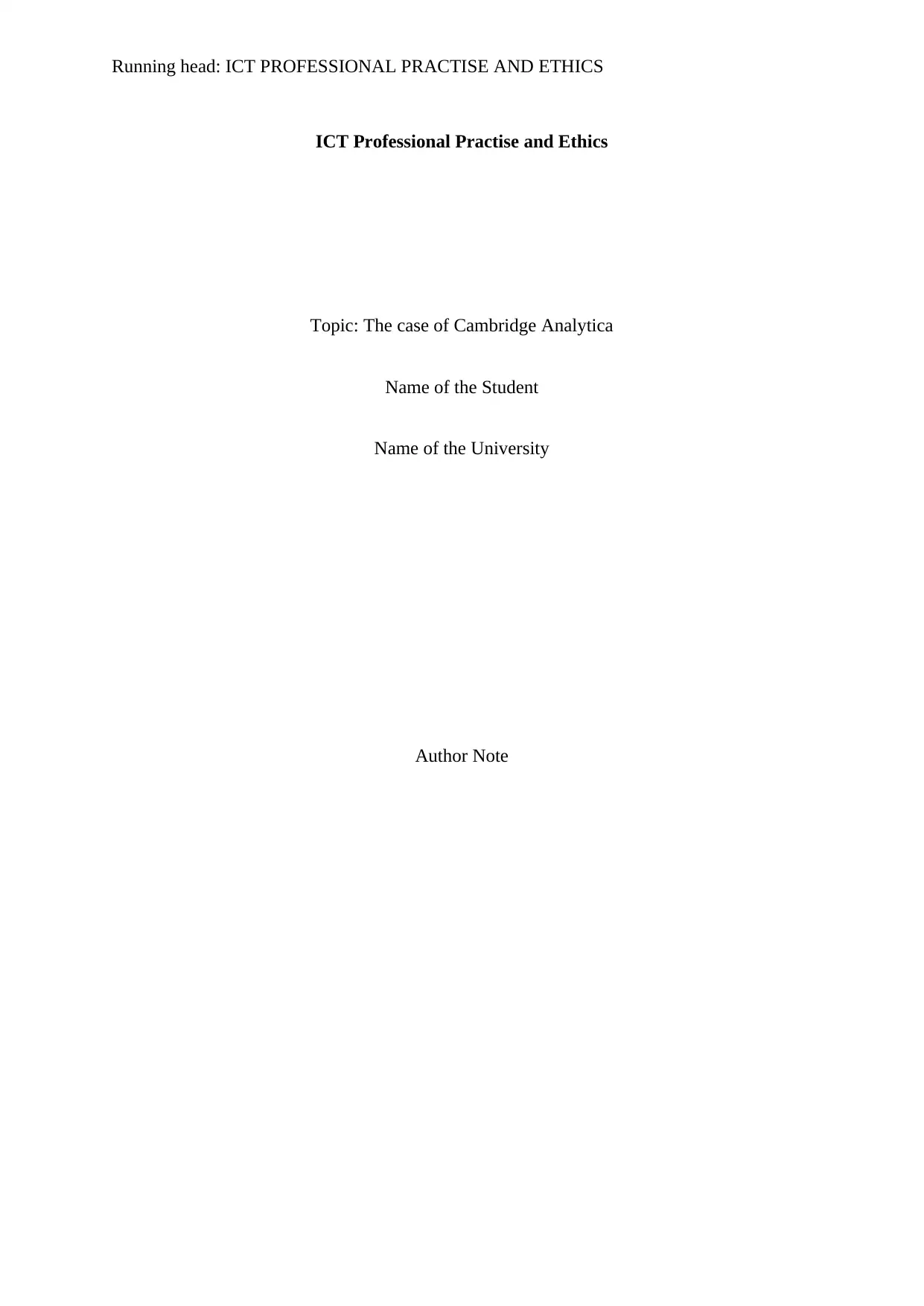
Running head: ICT PROFESSIONAL PRACTISE AND ETHICS
ICT Professional Practise and Ethics
Topic: The case of Cambridge Analytica
Name of the Student
Name of the University
Author Note
ICT Professional Practise and Ethics
Topic: The case of Cambridge Analytica
Name of the Student
Name of the University
Author Note
Paraphrase This Document
Need a fresh take? Get an instant paraphrase of this document with our AI Paraphraser
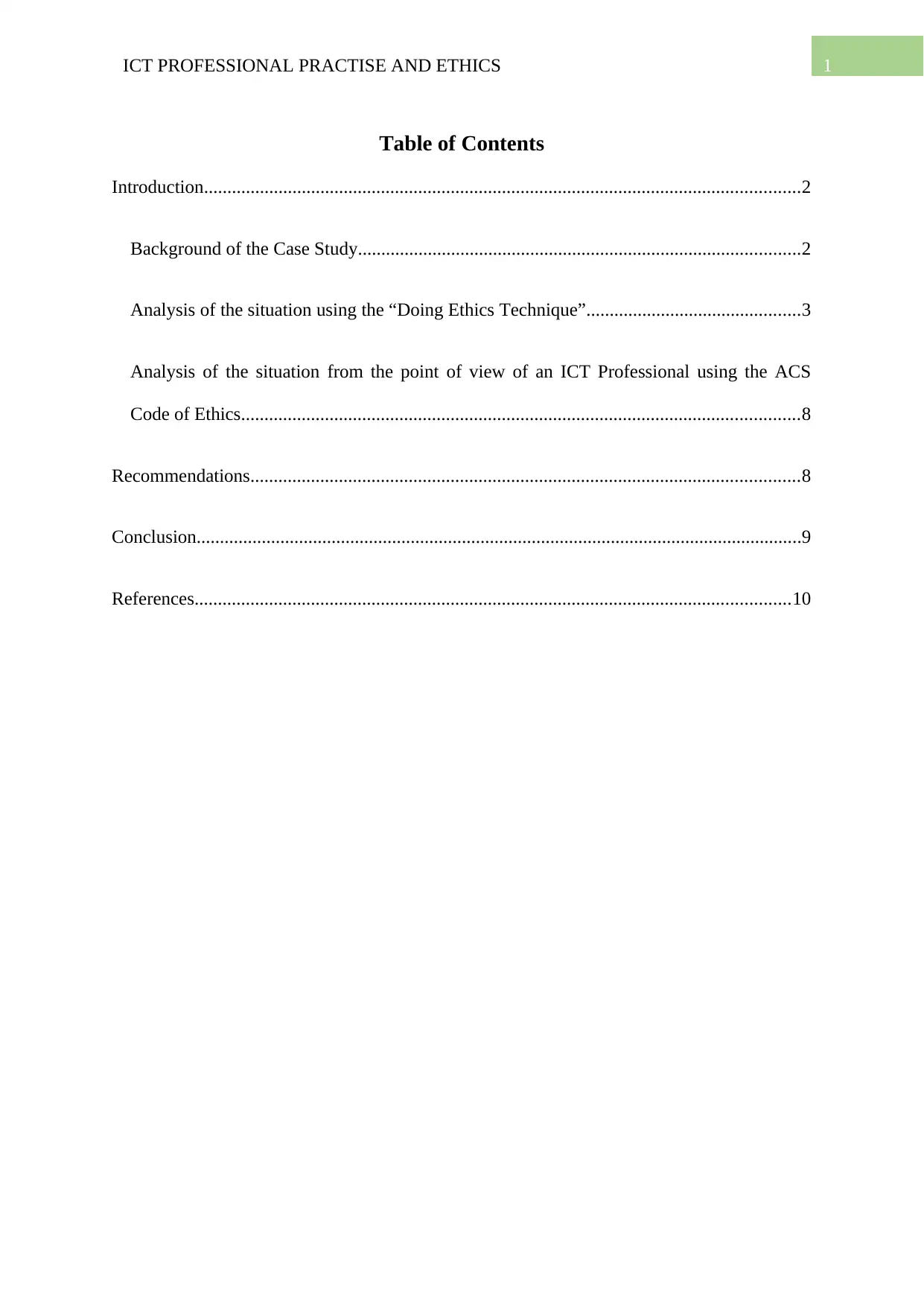
1ICT PROFESSIONAL PRACTISE AND ETHICS
Table of Contents
Introduction................................................................................................................................2
Background of the Case Study...............................................................................................2
Analysis of the situation using the “Doing Ethics Technique”..............................................3
Analysis of the situation from the point of view of an ICT Professional using the ACS
Code of Ethics........................................................................................................................8
Recommendations......................................................................................................................8
Conclusion..................................................................................................................................9
References................................................................................................................................10
Table of Contents
Introduction................................................................................................................................2
Background of the Case Study...............................................................................................2
Analysis of the situation using the “Doing Ethics Technique”..............................................3
Analysis of the situation from the point of view of an ICT Professional using the ACS
Code of Ethics........................................................................................................................8
Recommendations......................................................................................................................8
Conclusion..................................................................................................................................9
References................................................................................................................................10
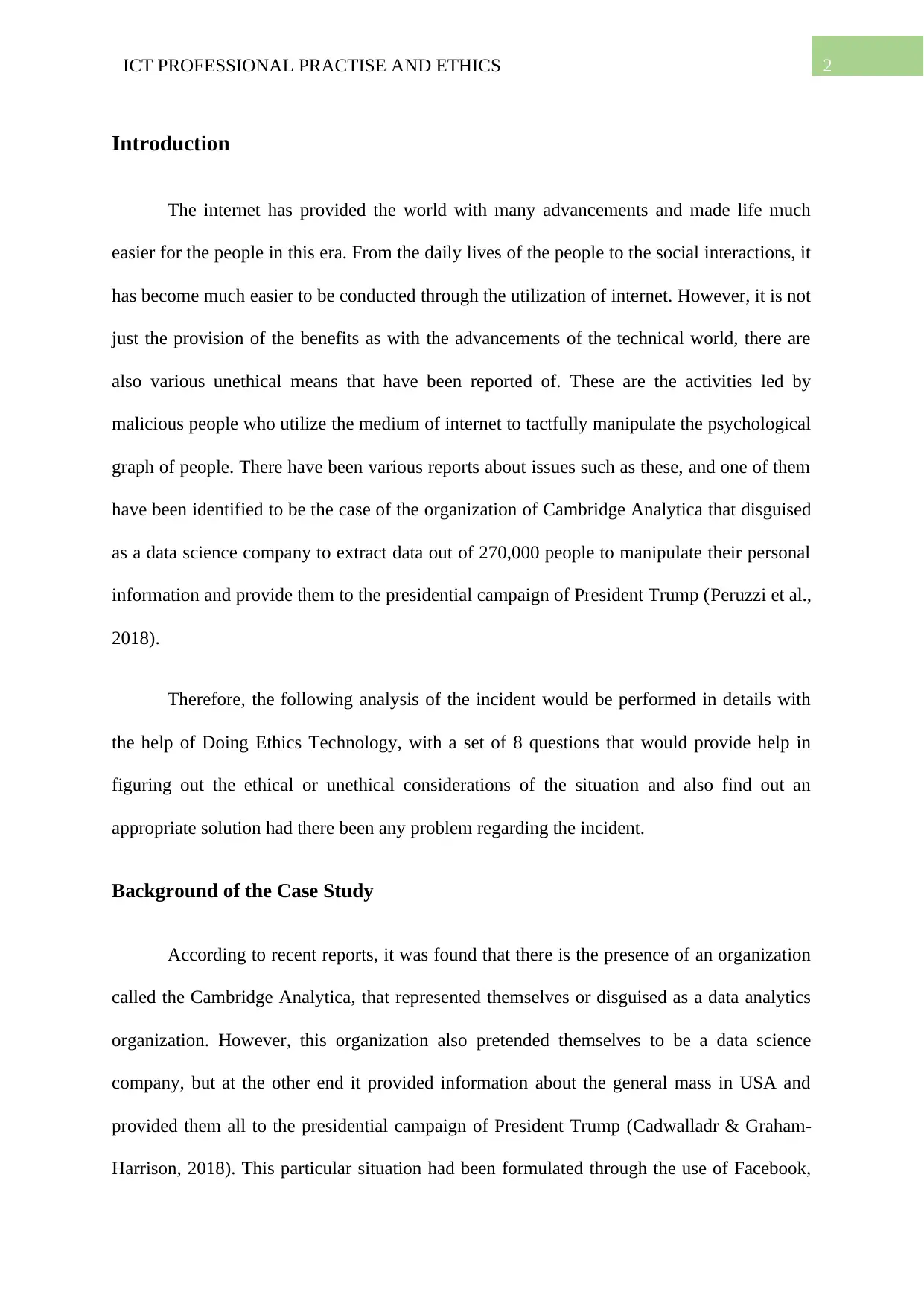
2ICT PROFESSIONAL PRACTISE AND ETHICS
Introduction
The internet has provided the world with many advancements and made life much
easier for the people in this era. From the daily lives of the people to the social interactions, it
has become much easier to be conducted through the utilization of internet. However, it is not
just the provision of the benefits as with the advancements of the technical world, there are
also various unethical means that have been reported of. These are the activities led by
malicious people who utilize the medium of internet to tactfully manipulate the psychological
graph of people. There have been various reports about issues such as these, and one of them
have been identified to be the case of the organization of Cambridge Analytica that disguised
as a data science company to extract data out of 270,000 people to manipulate their personal
information and provide them to the presidential campaign of President Trump (Peruzzi et al.,
2018).
Therefore, the following analysis of the incident would be performed in details with
the help of Doing Ethics Technology, with a set of 8 questions that would provide help in
figuring out the ethical or unethical considerations of the situation and also find out an
appropriate solution had there been any problem regarding the incident.
Background of the Case Study
According to recent reports, it was found that there is the presence of an organization
called the Cambridge Analytica, that represented themselves or disguised as a data analytics
organization. However, this organization also pretended themselves to be a data science
company, but at the other end it provided information about the general mass in USA and
provided them all to the presidential campaign of President Trump (Cadwalladr & Graham-
Harrison, 2018). This particular situation had been formulated through the use of Facebook,
Introduction
The internet has provided the world with many advancements and made life much
easier for the people in this era. From the daily lives of the people to the social interactions, it
has become much easier to be conducted through the utilization of internet. However, it is not
just the provision of the benefits as with the advancements of the technical world, there are
also various unethical means that have been reported of. These are the activities led by
malicious people who utilize the medium of internet to tactfully manipulate the psychological
graph of people. There have been various reports about issues such as these, and one of them
have been identified to be the case of the organization of Cambridge Analytica that disguised
as a data science company to extract data out of 270,000 people to manipulate their personal
information and provide them to the presidential campaign of President Trump (Peruzzi et al.,
2018).
Therefore, the following analysis of the incident would be performed in details with
the help of Doing Ethics Technology, with a set of 8 questions that would provide help in
figuring out the ethical or unethical considerations of the situation and also find out an
appropriate solution had there been any problem regarding the incident.
Background of the Case Study
According to recent reports, it was found that there is the presence of an organization
called the Cambridge Analytica, that represented themselves or disguised as a data analytics
organization. However, this organization also pretended themselves to be a data science
company, but at the other end it provided information about the general mass in USA and
provided them all to the presidential campaign of President Trump (Cadwalladr & Graham-
Harrison, 2018). This particular situation had been formulated through the use of Facebook,
⊘ This is a preview!⊘
Do you want full access?
Subscribe today to unlock all pages.

Trusted by 1+ million students worldwide
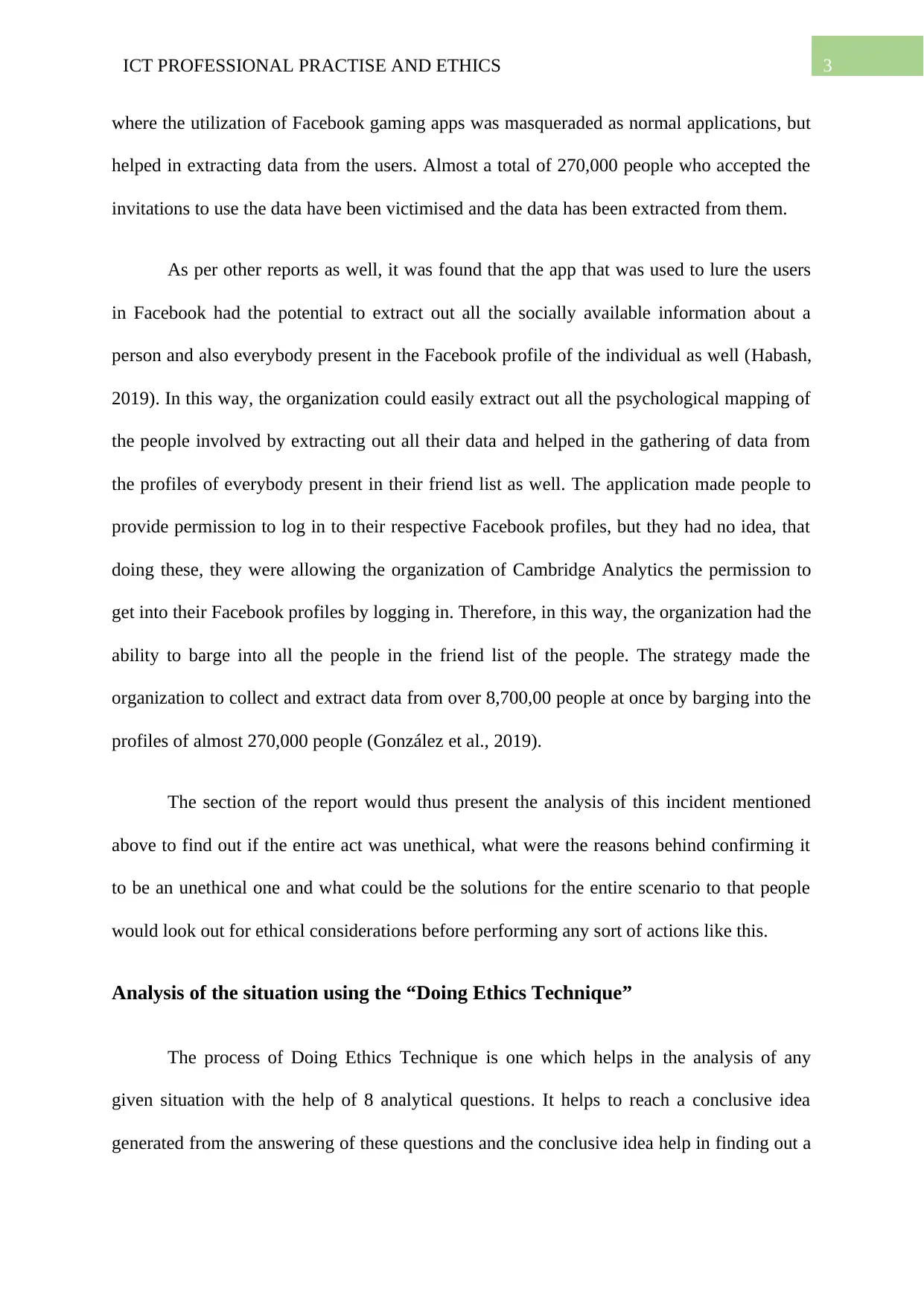
3ICT PROFESSIONAL PRACTISE AND ETHICS
where the utilization of Facebook gaming apps was masqueraded as normal applications, but
helped in extracting data from the users. Almost a total of 270,000 people who accepted the
invitations to use the data have been victimised and the data has been extracted from them.
As per other reports as well, it was found that the app that was used to lure the users
in Facebook had the potential to extract out all the socially available information about a
person and also everybody present in the Facebook profile of the individual as well (Habash,
2019). In this way, the organization could easily extract out all the psychological mapping of
the people involved by extracting out all their data and helped in the gathering of data from
the profiles of everybody present in their friend list as well. The application made people to
provide permission to log in to their respective Facebook profiles, but they had no idea, that
doing these, they were allowing the organization of Cambridge Analytics the permission to
get into their Facebook profiles by logging in. Therefore, in this way, the organization had the
ability to barge into all the people in the friend list of the people. The strategy made the
organization to collect and extract data from over 8,700,00 people at once by barging into the
profiles of almost 270,000 people (González et al., 2019).
The section of the report would thus present the analysis of this incident mentioned
above to find out if the entire act was unethical, what were the reasons behind confirming it
to be an unethical one and what could be the solutions for the entire scenario to that people
would look out for ethical considerations before performing any sort of actions like this.
Analysis of the situation using the “Doing Ethics Technique”
The process of Doing Ethics Technique is one which helps in the analysis of any
given situation with the help of 8 analytical questions. It helps to reach a conclusive idea
generated from the answering of these questions and the conclusive idea help in finding out a
where the utilization of Facebook gaming apps was masqueraded as normal applications, but
helped in extracting data from the users. Almost a total of 270,000 people who accepted the
invitations to use the data have been victimised and the data has been extracted from them.
As per other reports as well, it was found that the app that was used to lure the users
in Facebook had the potential to extract out all the socially available information about a
person and also everybody present in the Facebook profile of the individual as well (Habash,
2019). In this way, the organization could easily extract out all the psychological mapping of
the people involved by extracting out all their data and helped in the gathering of data from
the profiles of everybody present in their friend list as well. The application made people to
provide permission to log in to their respective Facebook profiles, but they had no idea, that
doing these, they were allowing the organization of Cambridge Analytics the permission to
get into their Facebook profiles by logging in. Therefore, in this way, the organization had the
ability to barge into all the people in the friend list of the people. The strategy made the
organization to collect and extract data from over 8,700,00 people at once by barging into the
profiles of almost 270,000 people (González et al., 2019).
The section of the report would thus present the analysis of this incident mentioned
above to find out if the entire act was unethical, what were the reasons behind confirming it
to be an unethical one and what could be the solutions for the entire scenario to that people
would look out for ethical considerations before performing any sort of actions like this.
Analysis of the situation using the “Doing Ethics Technique”
The process of Doing Ethics Technique is one which helps in the analysis of any
given situation with the help of 8 analytical questions. It helps to reach a conclusive idea
generated from the answering of these questions and the conclusive idea help in finding out a
Paraphrase This Document
Need a fresh take? Get an instant paraphrase of this document with our AI Paraphraser
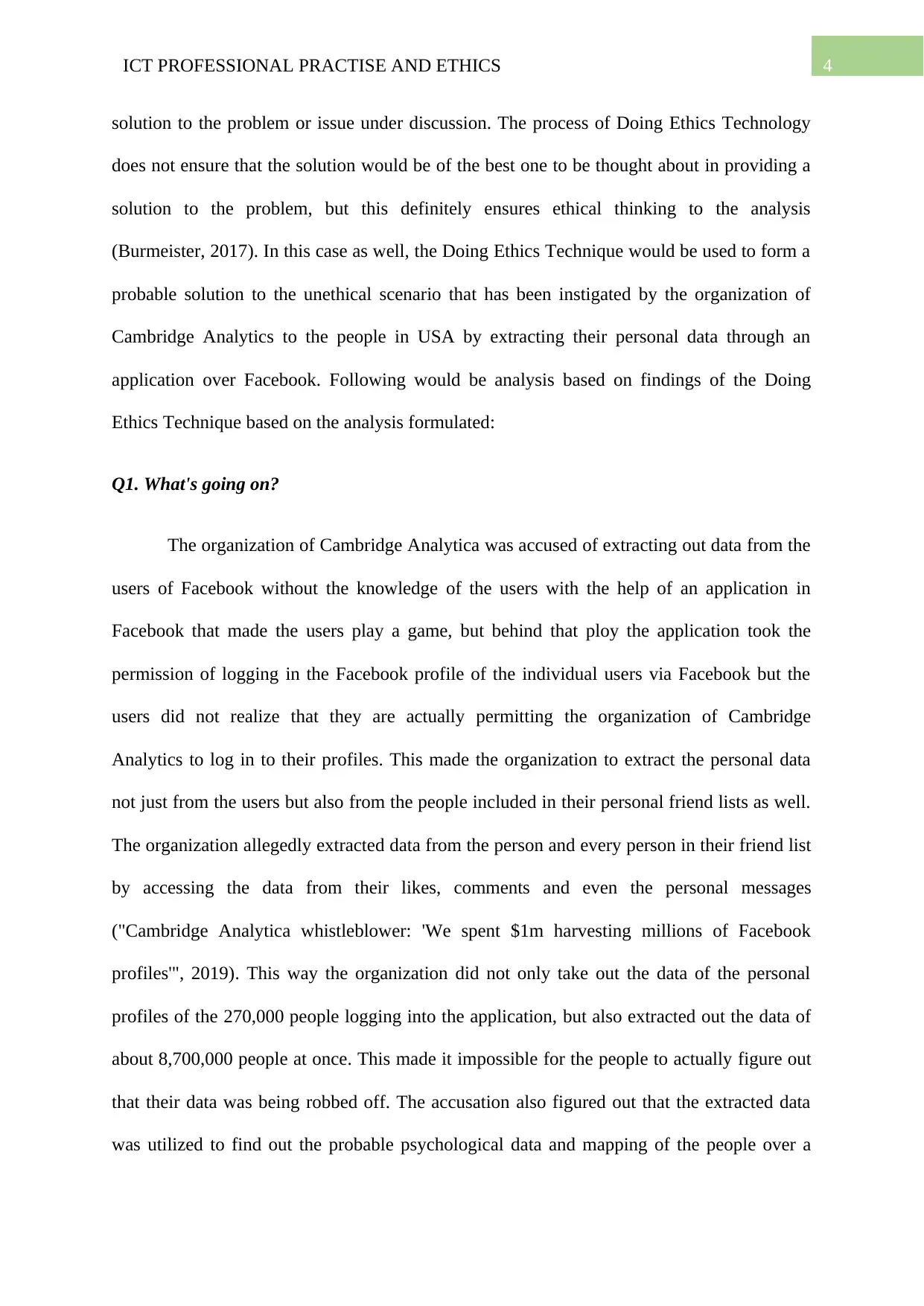
4ICT PROFESSIONAL PRACTISE AND ETHICS
solution to the problem or issue under discussion. The process of Doing Ethics Technology
does not ensure that the solution would be of the best one to be thought about in providing a
solution to the problem, but this definitely ensures ethical thinking to the analysis
(Burmeister, 2017). In this case as well, the Doing Ethics Technique would be used to form a
probable solution to the unethical scenario that has been instigated by the organization of
Cambridge Analytics to the people in USA by extracting their personal data through an
application over Facebook. Following would be analysis based on findings of the Doing
Ethics Technique based on the analysis formulated:
Q1. What's going on?
The organization of Cambridge Analytica was accused of extracting out data from the
users of Facebook without the knowledge of the users with the help of an application in
Facebook that made the users play a game, but behind that ploy the application took the
permission of logging in the Facebook profile of the individual users via Facebook but the
users did not realize that they are actually permitting the organization of Cambridge
Analytics to log in to their profiles. This made the organization to extract the personal data
not just from the users but also from the people included in their personal friend lists as well.
The organization allegedly extracted data from the person and every person in their friend list
by accessing the data from their likes, comments and even the personal messages
("Cambridge Analytica whistleblower: 'We spent $1m harvesting millions of Facebook
profiles'", 2019). This way the organization did not only take out the data of the personal
profiles of the 270,000 people logging into the application, but also extracted out the data of
about 8,700,000 people at once. This made it impossible for the people to actually figure out
that their data was being robbed off. The accusation also figured out that the extracted data
was utilized to find out the probable psychological data and mapping of the people over a
solution to the problem or issue under discussion. The process of Doing Ethics Technology
does not ensure that the solution would be of the best one to be thought about in providing a
solution to the problem, but this definitely ensures ethical thinking to the analysis
(Burmeister, 2017). In this case as well, the Doing Ethics Technique would be used to form a
probable solution to the unethical scenario that has been instigated by the organization of
Cambridge Analytics to the people in USA by extracting their personal data through an
application over Facebook. Following would be analysis based on findings of the Doing
Ethics Technique based on the analysis formulated:
Q1. What's going on?
The organization of Cambridge Analytica was accused of extracting out data from the
users of Facebook without the knowledge of the users with the help of an application in
Facebook that made the users play a game, but behind that ploy the application took the
permission of logging in the Facebook profile of the individual users via Facebook but the
users did not realize that they are actually permitting the organization of Cambridge
Analytics to log in to their profiles. This made the organization to extract the personal data
not just from the users but also from the people included in their personal friend lists as well.
The organization allegedly extracted data from the person and every person in their friend list
by accessing the data from their likes, comments and even the personal messages
("Cambridge Analytica whistleblower: 'We spent $1m harvesting millions of Facebook
profiles'", 2019). This way the organization did not only take out the data of the personal
profiles of the 270,000 people logging into the application, but also extracted out the data of
about 8,700,000 people at once. This made it impossible for the people to actually figure out
that their data was being robbed off. The accusation also figured out that the extracted data
was utilized to find out the probable psychological data and mapping of the people over a
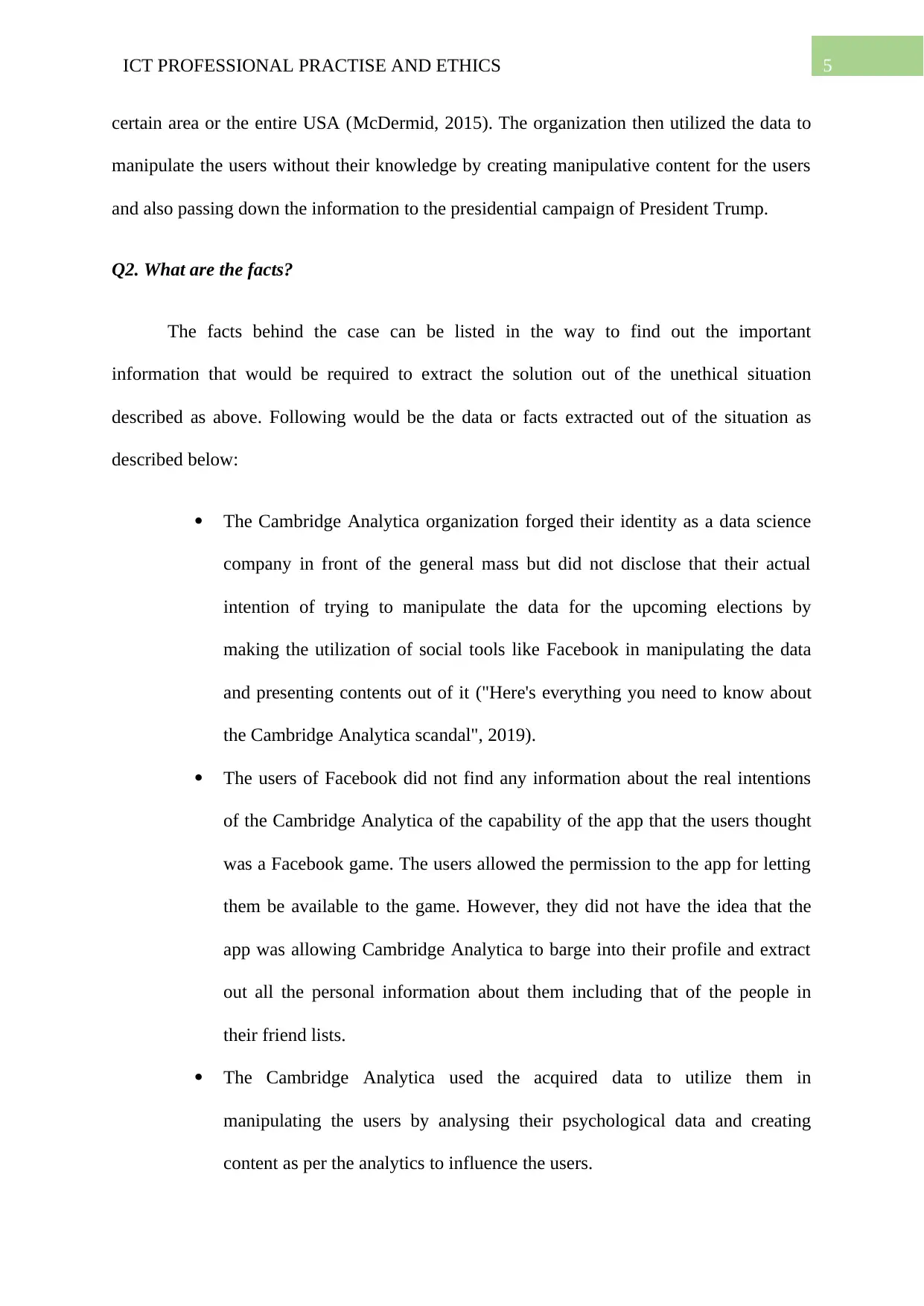
5ICT PROFESSIONAL PRACTISE AND ETHICS
certain area or the entire USA (McDermid, 2015). The organization then utilized the data to
manipulate the users without their knowledge by creating manipulative content for the users
and also passing down the information to the presidential campaign of President Trump.
Q2. What are the facts?
The facts behind the case can be listed in the way to find out the important
information that would be required to extract the solution out of the unethical situation
described as above. Following would be the data or facts extracted out of the situation as
described below:
The Cambridge Analytica organization forged their identity as a data science
company in front of the general mass but did not disclose that their actual
intention of trying to manipulate the data for the upcoming elections by
making the utilization of social tools like Facebook in manipulating the data
and presenting contents out of it ("Here's everything you need to know about
the Cambridge Analytica scandal", 2019).
The users of Facebook did not find any information about the real intentions
of the Cambridge Analytica of the capability of the app that the users thought
was a Facebook game. The users allowed the permission to the app for letting
them be available to the game. However, they did not have the idea that the
app was allowing Cambridge Analytica to barge into their profile and extract
out all the personal information about them including that of the people in
their friend lists.
The Cambridge Analytica used the acquired data to utilize them in
manipulating the users by analysing their psychological data and creating
content as per the analytics to influence the users.
certain area or the entire USA (McDermid, 2015). The organization then utilized the data to
manipulate the users without their knowledge by creating manipulative content for the users
and also passing down the information to the presidential campaign of President Trump.
Q2. What are the facts?
The facts behind the case can be listed in the way to find out the important
information that would be required to extract the solution out of the unethical situation
described as above. Following would be the data or facts extracted out of the situation as
described below:
The Cambridge Analytica organization forged their identity as a data science
company in front of the general mass but did not disclose that their actual
intention of trying to manipulate the data for the upcoming elections by
making the utilization of social tools like Facebook in manipulating the data
and presenting contents out of it ("Here's everything you need to know about
the Cambridge Analytica scandal", 2019).
The users of Facebook did not find any information about the real intentions
of the Cambridge Analytica of the capability of the app that the users thought
was a Facebook game. The users allowed the permission to the app for letting
them be available to the game. However, they did not have the idea that the
app was allowing Cambridge Analytica to barge into their profile and extract
out all the personal information about them including that of the people in
their friend lists.
The Cambridge Analytica used the acquired data to utilize them in
manipulating the users by analysing their psychological data and creating
content as per the analytics to influence the users.
⊘ This is a preview!⊘
Do you want full access?
Subscribe today to unlock all pages.

Trusted by 1+ million students worldwide
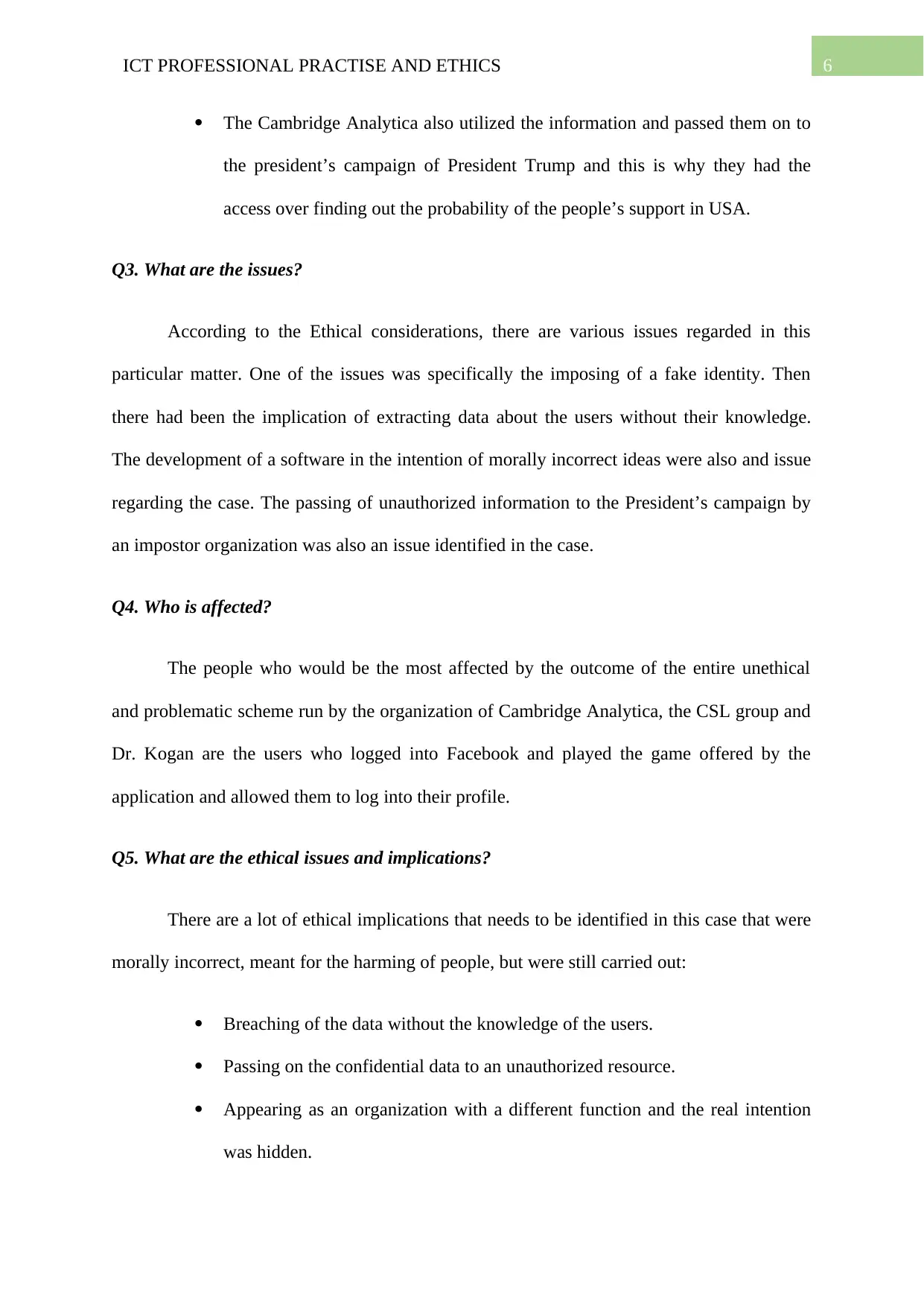
6ICT PROFESSIONAL PRACTISE AND ETHICS
The Cambridge Analytica also utilized the information and passed them on to
the president’s campaign of President Trump and this is why they had the
access over finding out the probability of the people’s support in USA.
Q3. What are the issues?
According to the Ethical considerations, there are various issues regarded in this
particular matter. One of the issues was specifically the imposing of a fake identity. Then
there had been the implication of extracting data about the users without their knowledge.
The development of a software in the intention of morally incorrect ideas were also and issue
regarding the case. The passing of unauthorized information to the President’s campaign by
an impostor organization was also an issue identified in the case.
Q4. Who is affected?
The people who would be the most affected by the outcome of the entire unethical
and problematic scheme run by the organization of Cambridge Analytica, the CSL group and
Dr. Kogan are the users who logged into Facebook and played the game offered by the
application and allowed them to log into their profile.
Q5. What are the ethical issues and implications?
There are a lot of ethical implications that needs to be identified in this case that were
morally incorrect, meant for the harming of people, but were still carried out:
Breaching of the data without the knowledge of the users.
Passing on the confidential data to an unauthorized resource.
Appearing as an organization with a different function and the real intention
was hidden.
The Cambridge Analytica also utilized the information and passed them on to
the president’s campaign of President Trump and this is why they had the
access over finding out the probability of the people’s support in USA.
Q3. What are the issues?
According to the Ethical considerations, there are various issues regarded in this
particular matter. One of the issues was specifically the imposing of a fake identity. Then
there had been the implication of extracting data about the users without their knowledge.
The development of a software in the intention of morally incorrect ideas were also and issue
regarding the case. The passing of unauthorized information to the President’s campaign by
an impostor organization was also an issue identified in the case.
Q4. Who is affected?
The people who would be the most affected by the outcome of the entire unethical
and problematic scheme run by the organization of Cambridge Analytica, the CSL group and
Dr. Kogan are the users who logged into Facebook and played the game offered by the
application and allowed them to log into their profile.
Q5. What are the ethical issues and implications?
There are a lot of ethical implications that needs to be identified in this case that were
morally incorrect, meant for the harming of people, but were still carried out:
Breaching of the data without the knowledge of the users.
Passing on the confidential data to an unauthorized resource.
Appearing as an organization with a different function and the real intention
was hidden.
Paraphrase This Document
Need a fresh take? Get an instant paraphrase of this document with our AI Paraphraser
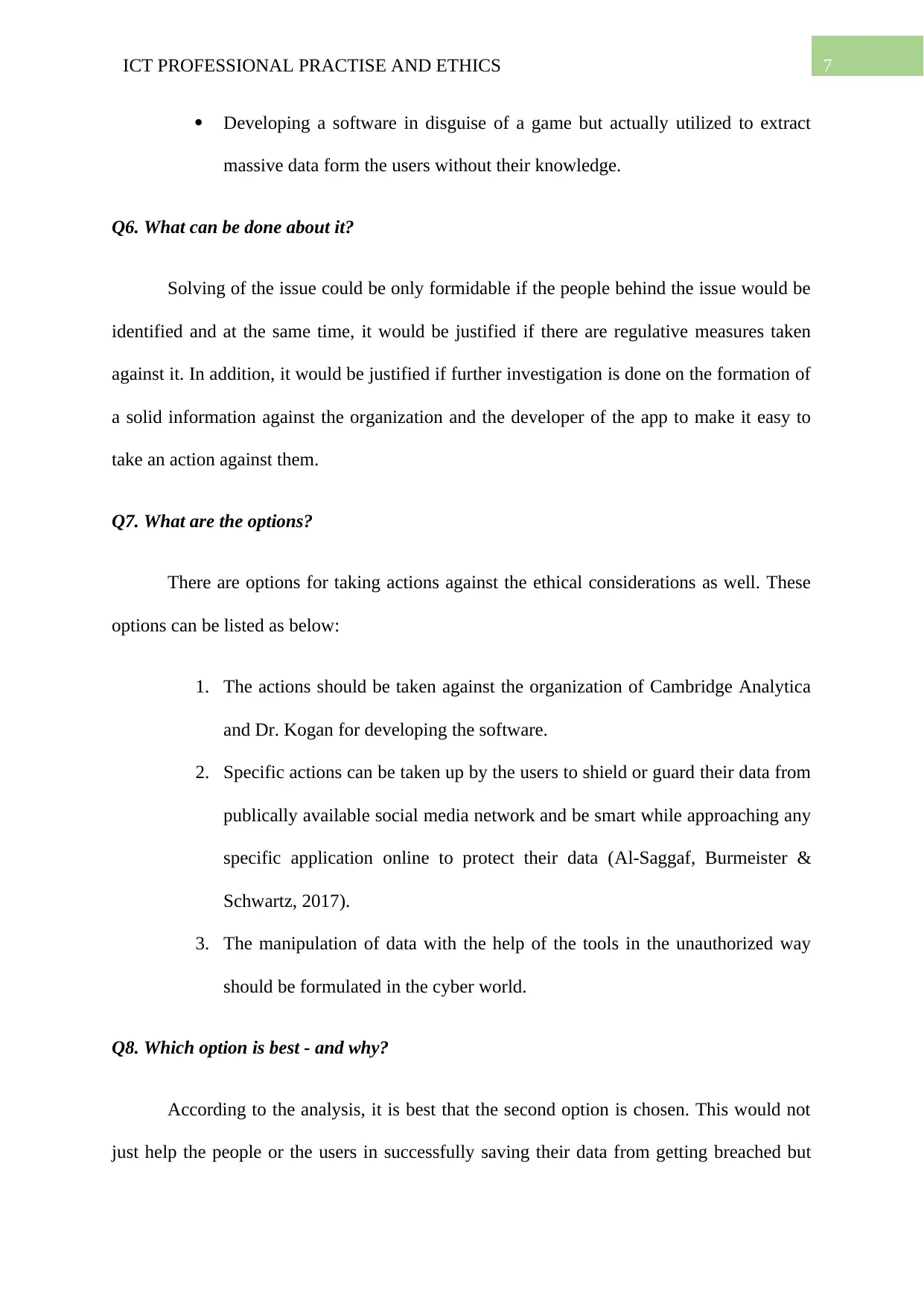
7ICT PROFESSIONAL PRACTISE AND ETHICS
Developing a software in disguise of a game but actually utilized to extract
massive data form the users without their knowledge.
Q6. What can be done about it?
Solving of the issue could be only formidable if the people behind the issue would be
identified and at the same time, it would be justified if there are regulative measures taken
against it. In addition, it would be justified if further investigation is done on the formation of
a solid information against the organization and the developer of the app to make it easy to
take an action against them.
Q7. What are the options?
There are options for taking actions against the ethical considerations as well. These
options can be listed as below:
1. The actions should be taken against the organization of Cambridge Analytica
and Dr. Kogan for developing the software.
2. Specific actions can be taken up by the users to shield or guard their data from
publically available social media network and be smart while approaching any
specific application online to protect their data (Al-Saggaf, Burmeister &
Schwartz, 2017).
3. The manipulation of data with the help of the tools in the unauthorized way
should be formulated in the cyber world.
Q8. Which option is best - and why?
According to the analysis, it is best that the second option is chosen. This would not
just help the people or the users in successfully saving their data from getting breached but
Developing a software in disguise of a game but actually utilized to extract
massive data form the users without their knowledge.
Q6. What can be done about it?
Solving of the issue could be only formidable if the people behind the issue would be
identified and at the same time, it would be justified if there are regulative measures taken
against it. In addition, it would be justified if further investigation is done on the formation of
a solid information against the organization and the developer of the app to make it easy to
take an action against them.
Q7. What are the options?
There are options for taking actions against the ethical considerations as well. These
options can be listed as below:
1. The actions should be taken against the organization of Cambridge Analytica
and Dr. Kogan for developing the software.
2. Specific actions can be taken up by the users to shield or guard their data from
publically available social media network and be smart while approaching any
specific application online to protect their data (Al-Saggaf, Burmeister &
Schwartz, 2017).
3. The manipulation of data with the help of the tools in the unauthorized way
should be formulated in the cyber world.
Q8. Which option is best - and why?
According to the analysis, it is best that the second option is chosen. This would not
just help the people or the users in successfully saving their data from getting breached but

8ICT PROFESSIONAL PRACTISE AND ETHICS
would also make sure that the future scope of such unethical means would save the users
every time form being affected by it.
Analysis of the situation from the point of view of an ICT Professional using the
ACS Code of Ethics
According to the ACS codes of ethical conduct, from the perspective of the ICT
Professional, the following would be considered:
1. Primacy of Public Interest: The Situation was not intended to serve the public
was made essentially to harm their data and using them they would manipulate
their political views.
2. Honesty: There was no honesty about the situation, right from the beginning
when they hid the intention of the organization from the users, and even when
they did not allow the intention behind the application to be known to the public
(Kuespert, 2017).
3. Professionalism: The idea behind the situation was entirely political, and
intended to destroy the society. They did not mean good for the enhancement of
the society and hence, this ethical code of conduct by ACS was also not followed.
Recommendations
It is recommended that the users are made aware of the information security systems
and techniques in the cyber world to make them understand how they can save their personal
data over the internet. These should be included in the day to day curriculum of the users to
make it a habit for them to strategically use the internet and save their data from getting
breached, hacked or extracted.
would also make sure that the future scope of such unethical means would save the users
every time form being affected by it.
Analysis of the situation from the point of view of an ICT Professional using the
ACS Code of Ethics
According to the ACS codes of ethical conduct, from the perspective of the ICT
Professional, the following would be considered:
1. Primacy of Public Interest: The Situation was not intended to serve the public
was made essentially to harm their data and using them they would manipulate
their political views.
2. Honesty: There was no honesty about the situation, right from the beginning
when they hid the intention of the organization from the users, and even when
they did not allow the intention behind the application to be known to the public
(Kuespert, 2017).
3. Professionalism: The idea behind the situation was entirely political, and
intended to destroy the society. They did not mean good for the enhancement of
the society and hence, this ethical code of conduct by ACS was also not followed.
Recommendations
It is recommended that the users are made aware of the information security systems
and techniques in the cyber world to make them understand how they can save their personal
data over the internet. These should be included in the day to day curriculum of the users to
make it a habit for them to strategically use the internet and save their data from getting
breached, hacked or extracted.
⊘ This is a preview!⊘
Do you want full access?
Subscribe today to unlock all pages.

Trusted by 1+ million students worldwide
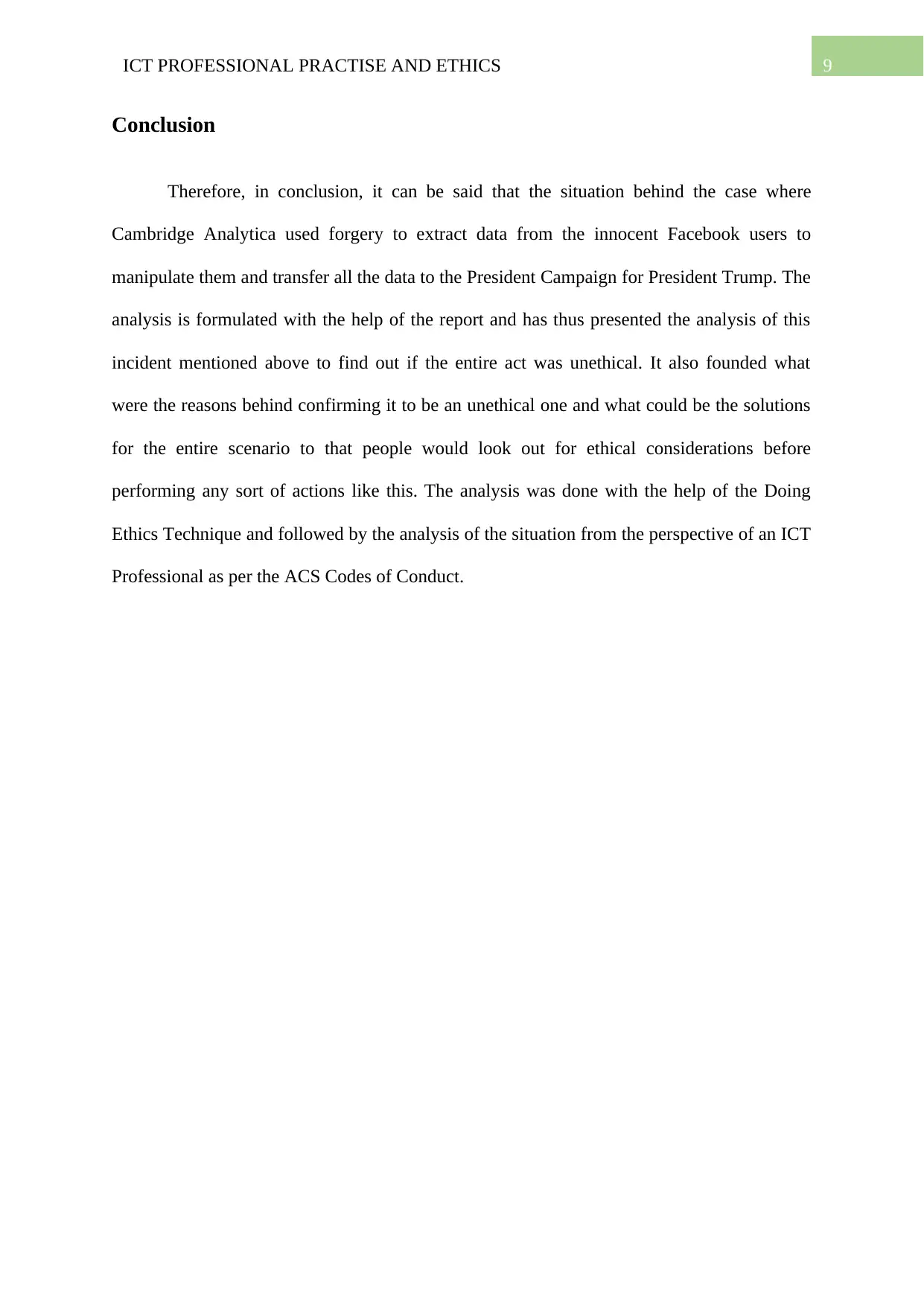
9ICT PROFESSIONAL PRACTISE AND ETHICS
Conclusion
Therefore, in conclusion, it can be said that the situation behind the case where
Cambridge Analytica used forgery to extract data from the innocent Facebook users to
manipulate them and transfer all the data to the President Campaign for President Trump. The
analysis is formulated with the help of the report and has thus presented the analysis of this
incident mentioned above to find out if the entire act was unethical. It also founded what
were the reasons behind confirming it to be an unethical one and what could be the solutions
for the entire scenario to that people would look out for ethical considerations before
performing any sort of actions like this. The analysis was done with the help of the Doing
Ethics Technique and followed by the analysis of the situation from the perspective of an ICT
Professional as per the ACS Codes of Conduct.
Conclusion
Therefore, in conclusion, it can be said that the situation behind the case where
Cambridge Analytica used forgery to extract data from the innocent Facebook users to
manipulate them and transfer all the data to the President Campaign for President Trump. The
analysis is formulated with the help of the report and has thus presented the analysis of this
incident mentioned above to find out if the entire act was unethical. It also founded what
were the reasons behind confirming it to be an unethical one and what could be the solutions
for the entire scenario to that people would look out for ethical considerations before
performing any sort of actions like this. The analysis was done with the help of the Doing
Ethics Technique and followed by the analysis of the situation from the perspective of an ICT
Professional as per the ACS Codes of Conduct.
Paraphrase This Document
Need a fresh take? Get an instant paraphrase of this document with our AI Paraphraser
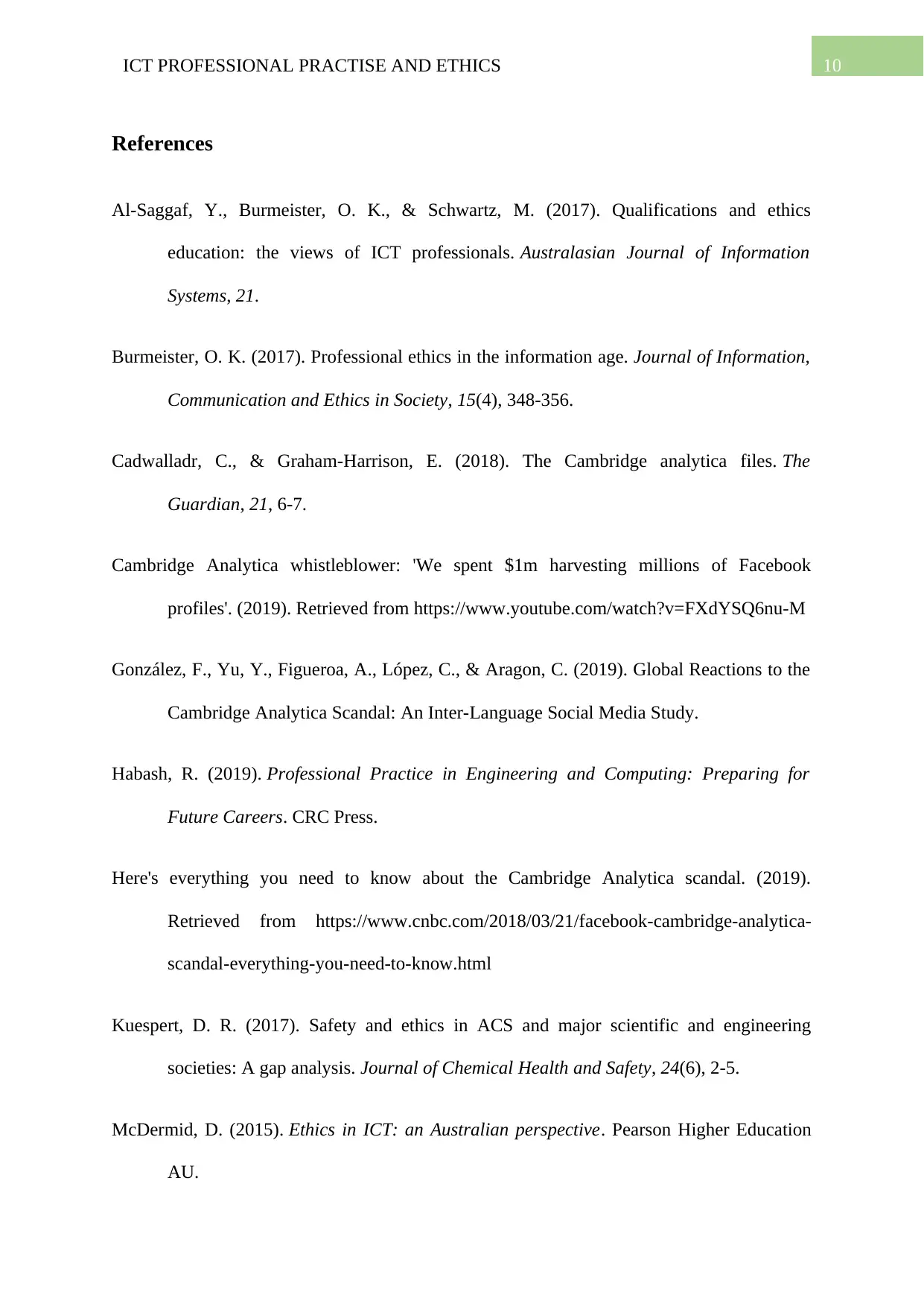
10ICT PROFESSIONAL PRACTISE AND ETHICS
References
Al-Saggaf, Y., Burmeister, O. K., & Schwartz, M. (2017). Qualifications and ethics
education: the views of ICT professionals. Australasian Journal of Information
Systems, 21.
Burmeister, O. K. (2017). Professional ethics in the information age. Journal of Information,
Communication and Ethics in Society, 15(4), 348-356.
Cadwalladr, C., & Graham-Harrison, E. (2018). The Cambridge analytica files. The
Guardian, 21, 6-7.
Cambridge Analytica whistleblower: 'We spent $1m harvesting millions of Facebook
profiles'. (2019). Retrieved from https://www.youtube.com/watch?v=FXdYSQ6nu-M
González, F., Yu, Y., Figueroa, A., López, C., & Aragon, C. (2019). Global Reactions to the
Cambridge Analytica Scandal: An Inter-Language Social Media Study.
Habash, R. (2019). Professional Practice in Engineering and Computing: Preparing for
Future Careers. CRC Press.
Here's everything you need to know about the Cambridge Analytica scandal. (2019).
Retrieved from https://www.cnbc.com/2018/03/21/facebook-cambridge-analytica-
scandal-everything-you-need-to-know.html
Kuespert, D. R. (2017). Safety and ethics in ACS and major scientific and engineering
societies: A gap analysis. Journal of Chemical Health and Safety, 24(6), 2-5.
McDermid, D. (2015). Ethics in ICT: an Australian perspective. Pearson Higher Education
AU.
References
Al-Saggaf, Y., Burmeister, O. K., & Schwartz, M. (2017). Qualifications and ethics
education: the views of ICT professionals. Australasian Journal of Information
Systems, 21.
Burmeister, O. K. (2017). Professional ethics in the information age. Journal of Information,
Communication and Ethics in Society, 15(4), 348-356.
Cadwalladr, C., & Graham-Harrison, E. (2018). The Cambridge analytica files. The
Guardian, 21, 6-7.
Cambridge Analytica whistleblower: 'We spent $1m harvesting millions of Facebook
profiles'. (2019). Retrieved from https://www.youtube.com/watch?v=FXdYSQ6nu-M
González, F., Yu, Y., Figueroa, A., López, C., & Aragon, C. (2019). Global Reactions to the
Cambridge Analytica Scandal: An Inter-Language Social Media Study.
Habash, R. (2019). Professional Practice in Engineering and Computing: Preparing for
Future Careers. CRC Press.
Here's everything you need to know about the Cambridge Analytica scandal. (2019).
Retrieved from https://www.cnbc.com/2018/03/21/facebook-cambridge-analytica-
scandal-everything-you-need-to-know.html
Kuespert, D. R. (2017). Safety and ethics in ACS and major scientific and engineering
societies: A gap analysis. Journal of Chemical Health and Safety, 24(6), 2-5.
McDermid, D. (2015). Ethics in ICT: an Australian perspective. Pearson Higher Education
AU.
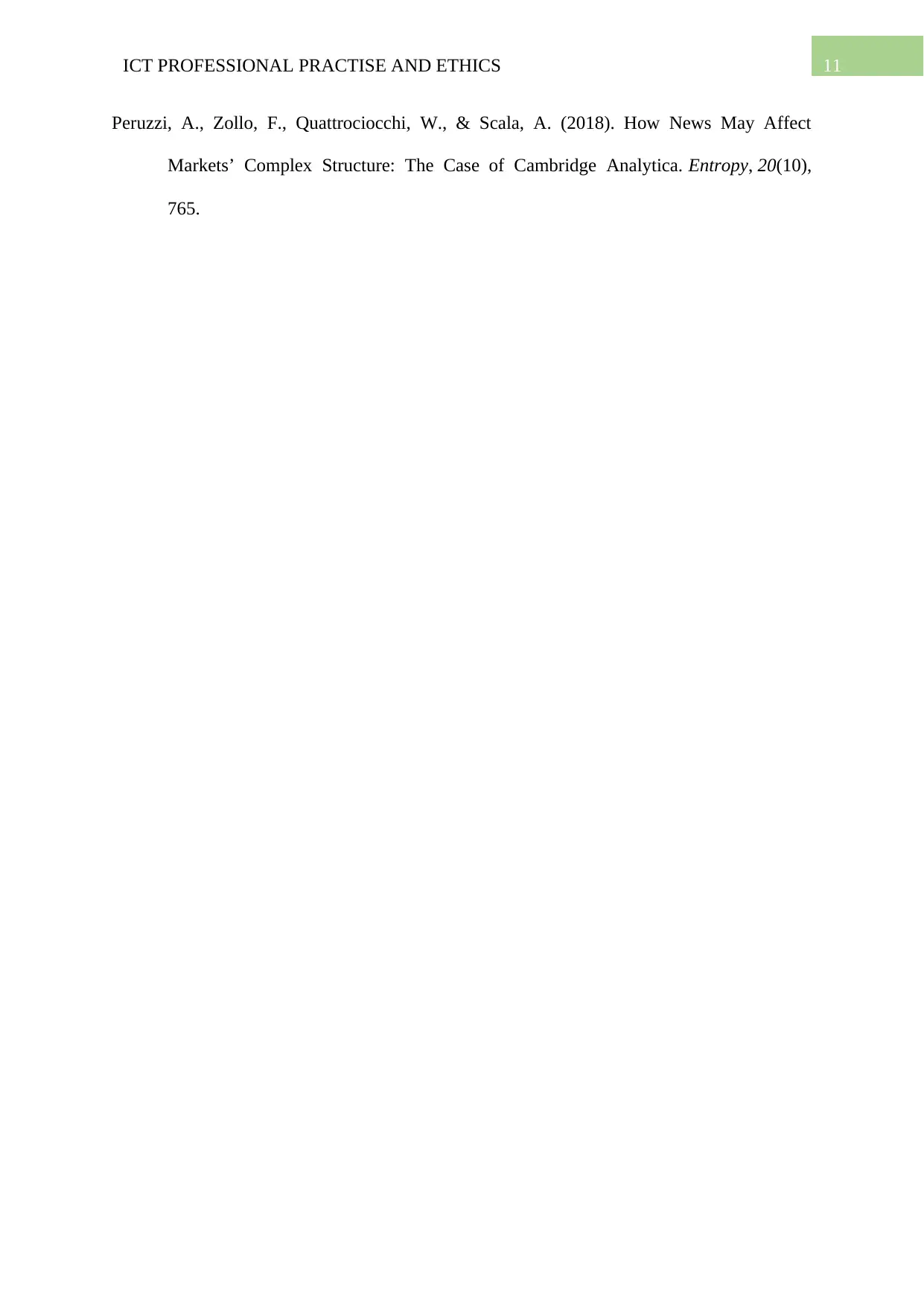
11ICT PROFESSIONAL PRACTISE AND ETHICS
Peruzzi, A., Zollo, F., Quattrociocchi, W., & Scala, A. (2018). How News May Affect
Markets’ Complex Structure: The Case of Cambridge Analytica. Entropy, 20(10),
765.
Peruzzi, A., Zollo, F., Quattrociocchi, W., & Scala, A. (2018). How News May Affect
Markets’ Complex Structure: The Case of Cambridge Analytica. Entropy, 20(10),
765.
⊘ This is a preview!⊘
Do you want full access?
Subscribe today to unlock all pages.

Trusted by 1+ million students worldwide
1 out of 12
Related Documents
Your All-in-One AI-Powered Toolkit for Academic Success.
+13062052269
info@desklib.com
Available 24*7 on WhatsApp / Email
![[object Object]](/_next/static/media/star-bottom.7253800d.svg)
Unlock your academic potential
Copyright © 2020–2025 A2Z Services. All Rights Reserved. Developed and managed by ZUCOL.




